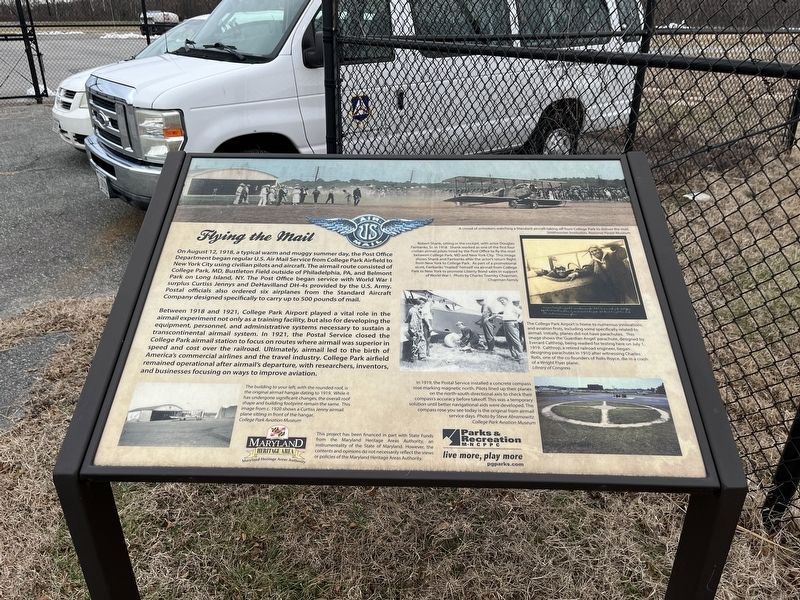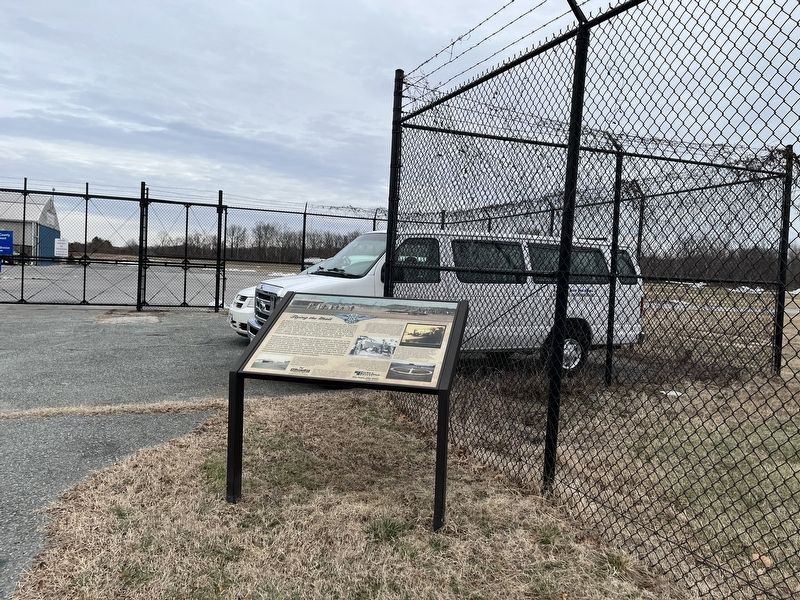College Park in Prince George's County, Maryland — The American Northeast (Mid-Atlantic)
Flying the Mail
On August 12, 1918, a typical warm and muggy summer day, the Post Office Department began regular U.S. Air Mail Service from College Park Airfield to New York City using civilian pilots and aircraft. The airmail route consisted of College Park, MD, Bustleton Field outside of Philadelphia, PA, and Belmont Park on Long Island, NY. The Post Office began service with World War I surplus Curtiss Jennys and DeHavilland DH-4s provided by the U.S. Army. Postal officials also ordered six airplanes from the Standard Aircraft Company designed specifically to carry up to 500 pounds of mail.
Between 1918 and 1921, College Park Airport played a vital role in the airmail experiment not only as a training facility, but also for developing the equipment, personnel, and administrative systems necessary to sustain a transcontinental airmail system. In 1921, the Postal Service closed the College Park airmail station to focus on routes where airmail was superior in speed and cost over the railroad. Ultimately, airmail led to the birth of America's commercial airlines and the travel industry. College Park airfield remained operational after airmail's departure, with researchers, inventors, and businesses focusing on ways to improve aviation.
[Captions:]
Robert Shank, sitting in the cockpit with actor Douglas Fairbanks, Sr. in 1918. Shank worked as one of the first four civilian airmail pilots hired by the Post Office to fly the mail between College Park, MD and New York City. This image shows Shank and Fairbanks after the actor's return flight from New York to College Park. As part of a promotional stunt, Fairbanks "mailed" himself via airmail from College Park to New York to promote Liberty Bond sales in support of World War I. Photo by Charles Townley Chapman, Chapman Family
The College Park Airport is home to numerous innovations and aviation firsts, including some specifically related to airmail. Initially, planes did not have parachutes. This image shows the 'Guardian Angel' parachute, designed by Everard Calthrop, being readied for testing here on July 1, 1919. Calthrop, a retired railroad engineer, began designing parachutes in 1910 after witnessing Charles Rolls, one of the co-founders of Rolls-Royce, die in a crash of a Wright Flyer plane. Library of Congress
In 1919, the Postal Service installed a concrete compass rose marking magnetic north. Pilots lined up their planes on the north-south directional axis to check their compass's accuracy before takeoff. This was a temporary solution until better navigational aids were developed. The compass rose you see today is the original from airmail service days. Photo by Steve Abramowitz, College Park Aviation
The building to your left, with the rounded roof, is the original airmail hangar dating to 1919. While it has undergone significant changes, the overall roof shape and building footprint remain the same. This image from c. 1920 shows a Curtiss Jenny airmail plane sitting in front of the hangar. College Park Aviation Museum
Erected by Maryland Heritage Area Authority; Maryland National Capital Parks & Planning Commission, Parks & Recreation.
Topics and series. This historical marker is listed in these topic lists: Air & Space • Communications • Education • Industry & Commerce. In addition, it is included in the Postal Mail and Philately series list. A significant historical date for this entry is July 1, 1919.
Location. 38° 58.872′ N, 76° 55.597′ W. Marker is in College Park, Maryland, in Prince George's County. Marker is on Cpl Frank Scott Drive, 0.3 miles west of College Avenue, on the right when traveling north. Touch for map. Marker is at or near this postal address: 1909 Cpl Frank Scott Dr, College Park MD 20740, United States of America. Touch for directions.
Other nearby markers. At least 8 other markers are within walking distance of this marker. America's Military Takes Flight (within shouting distance of this marker); College Park Airport (within shouting distance of this marker); Arthur "Al" Welsh, 1881-1912: Pioneer Aviator (about 600 feet away, measured in a direct line); a different marker also named College Park Airport (approx. 0.2 miles away); Taliaferro House (approx. 0.2 miles away); a different marker also named College Park Airport (approx. 0.2 miles away); Cory House (approx. 0.2 miles away); City of College Park (approx. ¼ mile away). Touch for a list and map of all markers in College Park.
Credits. This page was last revised on January 16, 2022. It was originally submitted on January 16, 2022, by Devry Becker Jones of Washington, District of Columbia. This page has been viewed 134 times since then and 13 times this year. Photos: 1, 2. submitted on January 16, 2022, by Devry Becker Jones of Washington, District of Columbia.

